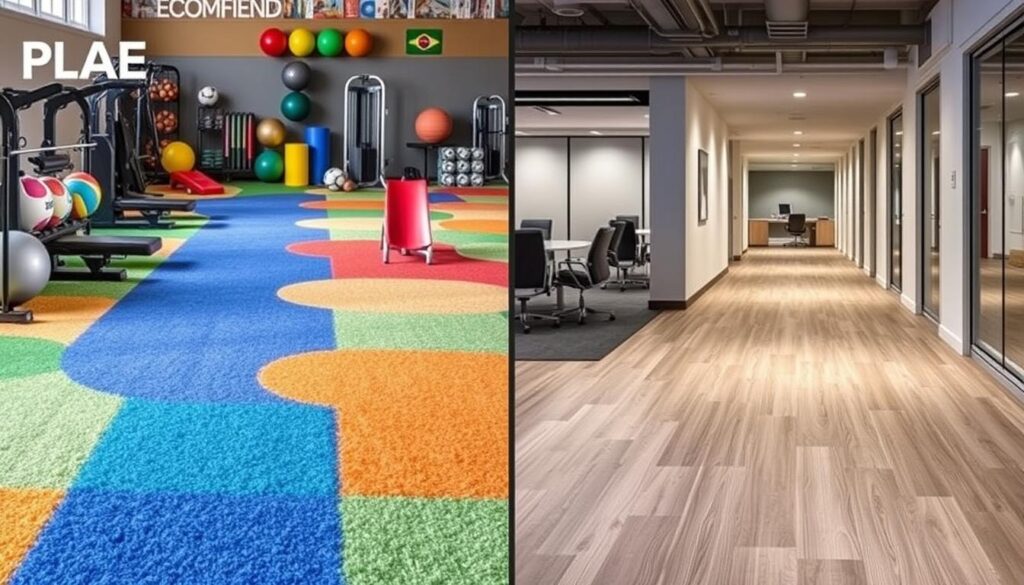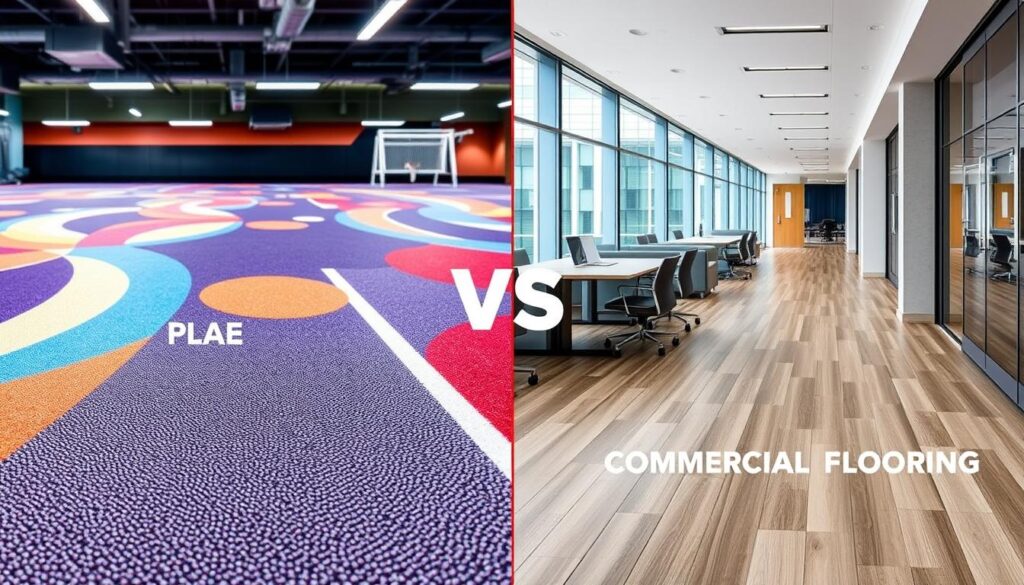Weighing PLAE flooring vs. commercial flooring? Our guide highlights the critical distinctions to help you choose the right fit.
Choosing the right flooring for a facility is important. There are many options, including PLAE flooring and commercial flooring. Each has its own benefits and characteristics. Knowing the differences helps facility managers make the best choice for their needs.
In the U.S., owners often look for durable, easy-to-maintain flooring. PLAE flooring has become popular for its unique material and making process. By comparing PLAE and commercial flooring, owners can find the best fit for their facility.

Introduction to Flooring Types
Facility owners should look at different flooring types, like commercial flooring solutions. They should consider the material, making process, and how well each flooring performs. This helps choose the best flooring for their facility.
Key Takeaways
- PLAE flooring and commercial flooring have distinct material compositions and manufacturing processes.
- Commercial flooring solutions offer durability and low-maintenance requirements.
- Facility owners should evaluate the performance characteristics of each flooring type.
- Installation requirements and maintenance needs vary between PLAE flooring and commercial flooring.
- Choosing the right flooring type depends on the specific needs of the facility.
- Understanding the key differences between flooring types can help facility owners make informed decisions.
Understanding PLAE Flooring and Commercial Flooring Basics
Choosing the right flooring for a facility is key. PLAE flooring has unique benefits that differ from traditional commercial flooring. It’s important to compare these types of flooring materials.
To make a good choice, you need to know the differences between PLAE and commercial flooring. Look at their composition, durability, and upkeep needs. This helps facility owners decide which flooring is best for them.
What is PLAE Flooring?
PLAE flooring is durable and easy to maintain. It’s great for areas with lots of foot traffic. Compared to commercial flooring, PLAE has special features that make it appealing for facilities.
Traditional Commercial Flooring Defined
Commercial flooring includes many materials, each with its own benefits and drawbacks. Options range from carpet and hardwood to tile and concrete. It’s important to compare these to find the right fit for a facility.
Core Material Differences
PLAE flooring and commercial flooring differ in materials. PLAE uses high-quality materials for heavy use. Commercial flooring materials vary in quality and durability. Knowing these differences helps facility owners choose the right flooring.
Material Composition and Manufacturing Process
The type of flooring you choose affects its performance, durability, and how green it is. Knowing what materials are used and how they’re made is key. This helps you see how they impact the environment, cost, and how well they last.
How flooring is made can differ a lot. It might use natural stuff or recycled materials. Flooring material composition can include wood, stone, or synthetic stuff. The materials and making process can change how long it lasts, how easy it is to clean, and its overall quality.
When looking at flooring, consider these important points:
- Where the materials come from and if they’re sustainable
- How much energy and emissions are used during making
- How much waste is reduced and recycled
- How well the quality is checked and tested
Knowing about flooring materials and how they’re made helps you make better choices. This includes thinking about cost, how well it works, and its effect on the planet.
Video source from Youtube
Performance Characteristics of Both Flooring Types
When we talk about flooring, we look at how well it holds up. This includes how it handles impacts, how much weight it can bear, and how long it lasts. Knowing these things helps us pick the right flooring for where it will be used.
Impact resistance is key. It shows how well a floor can handle sudden drops or hits. Load bearing capacity is also important. It tells us how much weight a floor can handle without breaking or bending.
Impact Resistance
Impact resistance is crucial. It shows how well a floor can handle sudden shocks. Floors with high impact resistance can better absorb shocks, keeping them looking good longer.
Load Bearing Capacity
Load bearing capacity is also very important. It shows how much weight a floor can handle. This is especially important in places where lots of people walk or where heavy things are moved.
Both PLAE flooring and commercial flooring have their good points and bad points. By looking at their impact resistance, load bearing capacity, and other features, we can choose the best flooring for our needs.
| Flooring Type | Impact Resistance | Load Bearing Capacity |
|---|---|---|
| PLAE Flooring | High | Medium-High |
| Commercial Flooring | Medium | High |
PLAE Flooring vs Commercial Flooring: A Direct Comparison
When comparing flooring, PLAE and commercial floors stand out. Facility owners often debate which is better. PLAE flooring is tough and can handle lots of foot traffic, perfect for busy spots.
Commercial flooring is loved for its looks and flexibility. But PLAE flooring has its own perks, like being easy to clean and fix. Here’s a quick look at what sets them apart:
| Feature | PLAE Flooring | Commercial Flooring |
|---|---|---|
| Material Composition | Durable, high-density materials | Versatile, aesthetic materials |
| Performance Characteristics | High impact resistance, load-bearing capacity | Slip resistance, acoustic properties |
| Maintenance and Repair | Ease of maintenance, repair | Regular maintenance required |
Choosing between PLAE and commercial flooring depends on your facility’s needs. By looking at the PLAE flooring vs commercial flooring comparison, you can pick the best option for your space.

Installation Requirements and Methodology
Installing flooring right is key to its lasting quality and performance. The needs for PLAE flooring and commercial flooring differ a lot. This affects the cost, time, and effort needed for the job. Knowing these details is vital for planning and setting a budget.
Getting the subfloor ready is a big part of flooring installation. It needs to be smooth and even for a good job. Any problems with the subfloor can cause issues like buckling or cracking. A pro will check the subfloor carefully and fix any problems found.
- Time and labor requirements: The installation process can be time-consuming and labor-intensive, requiring specialized tools and equipment.
- Subfloor preparation: The subfloor must be properly prepared to ensure a successful installation, including cleaning, leveling, and priming.
- Material handling: The flooring materials must be handled and installed correctly to prevent damage and ensure a smooth finish.
A professional installation process considers all these factors and more. This ensures a smooth and worry-free flooring installation. Choosing a skilled and reliable installer means your flooring will be installed correctly. It will meet your needs and expectations.
Maintenance and Longevity Factors
Both PLAE flooring and commercial flooring need regular care to last long. Daily sweeping and weekly mopping are key for PLAE flooring. Commercial flooring might need more cleaning because of lots of people walking by.
Many things can affect how long flooring lasts. These include how well it’s installed, how often it’s cleaned, and the environment around it. For example, too much sunlight or very hot or cold temperatures can damage flooring. To protect it, you can use special coatings or add shades.
Here are some important things to think about for flooring maintenance and longevity factors:
- Regularly check and fix any damage
- Use cleaning products and methods suggested by the maker
- Make a maintenance plan to keep things consistent
Understanding and dealing with these longevity factors can help flooring last longer. This means you won’t have to spend a lot on fixing or replacing it. Good flooring maintenance also makes your place look better and safer. It makes it a nicer and more productive space for everyone.
| Factor | PLAE Flooring | Commercial Flooring |
|---|---|---|
| Maintenance Frequency | Daily sweeping, weekly mopping | Frequent cleaning due to high foot traffic |
| Longevity | 10-15 years | 5-10 years |
| Environmental Impact | Resistant to fading and warping | May be affected by direct sunlight or extreme temperatures |
Cost Analysis and Return on Investment
Choosing between PLAE flooring and commercial flooring requires a detailed cost analysis. This analysis should look at the initial costs, long-term maintenance, and replacement costs. By comparing the return on investment, readers can decide based on their budget and goals.
The initial installation cost is a key factor. It varies by flooring type, area size, and installation complexity. Long-term maintenance costs also add up. A good analysis should consider these costs and the flooring’s lifespan.
The table below compares the costs of PLAE flooring and commercial flooring:
| Flooring Type | Initial Installation Cost | Long-term Maintenance Expenses | Potential Replacement Costs |
|---|---|---|---|
| PLAE Flooring | $10-$20 per square foot | $0.50-$1.00 per square foot per year | $5-$10 per square foot |
| Commercial Flooring | $5-$15 per square foot | $1.00-$2.00 per square foot per year | $10-$20 per square foot |
By looking at these factors and the return on investment, readers can make a smart choice. This choice should fit their budget and financial goals.
Environmental Impact and Sustainability Features
Choosing the right flooring for a facility means looking at its environmental impact and sustainability. The environmental impact of PLAE flooring and commercial flooring differs a lot. This depends on the materials used, how they’re made, and what happens to them when they’re no longer needed.
Using eco-friendly materials is a big part of sustainability features. Flooring made from recycled materials or wood from sustainable forests is better for the planet. The way flooring is made also affects the environment. Some methods use more energy or create more waste than others.
Here are some key things to think about when looking at flooring’s environmental impact and sustainability:
- Material sourcing: Where do the materials come from, and are they sustainable?
- Manufacturing process: What’s the environmental effect of making the flooring, and can it be improved?
- End-of-life disposal or recycling: What options are there for getting rid of or recycling the flooring, and how can it be done greenly?

By looking at these points and comparing different flooring options, facilities can make choices that match their environmental values. This helps reduce the facility’s environmental footprint and supports a greener future.
| Flooring Option | Environmental Impact | Sustainability Features |
|---|---|---|
| PLAE Flooring | Lower environmental impact due to sustainable materials and manufacturing process | Eco-friendly materials, recyclable, and reusable |
| Commercial Flooring | Higher environmental impact due to non-sustainable materials and manufacturing process | Limited recycling options, non-renewable materials |
Conclusion: Making the Right Choice for Your Facility
Choosing the right flooring for your facility is all about understanding your space’s needs. Whether you pick PLAE flooring or traditional commercial flooring, consider several factors. These include performance, installation, maintenance, and cost over time.
PLAE flooring is great for places with lots of people or where safety and comfort are key. It’s tough, slip-resistant, and helps with sound. Commercial flooring, however, is strong and might save money in some cases.
This guide has shown you the main differences between PLAE and commercial flooring. Use this knowledge to choose the best flooring for your facility. Think about what matters most to your operations and the value over time. This will help you make a smart decision for your space.
FAQ
What is the difference between PLAE flooring and commercial flooring?
PLAE flooring and commercial flooring are different in many ways. PLAE flooring has unique features and benefits. Commercial flooring, on the other hand, includes many types, each with its own advantages and drawbacks.
What are the core material differences between PLAE flooring and commercial flooring?
The materials used in PLAE flooring and commercial flooring affect their performance and durability. PLAE flooring uses special materials. Commercial flooring can be made from vinyl, rubber, carpet, and more.
How do the performance characteristics of PLAE flooring and commercial flooring compare?
PLAE flooring and commercial flooring have different performance features. These include impact resistance, load-bearing capacity, slip resistance, and acoustic properties. Knowing these differences helps choose the right flooring for specific needs.
What are the installation requirements for PLAE flooring and commercial flooring?
Installing PLAE flooring and commercial flooring can be different. The process, time, and subfloor needs vary. These factors affect the cost and time needed for installation.
How do the maintenance and longevity factors of PLAE flooring and commercial flooring compare?
Maintenance and longevity of PLAE flooring and commercial flooring differ. Cleaning, repair, and replacement needs vary. The lifespan of each flooring type is also a consideration.
What are the cost considerations and return on investment for PLAE flooring and commercial flooring?
The cost of PLAE flooring and commercial flooring includes more than just installation. Maintenance and replacement costs are also important. Evaluating the return on investment helps make a budget-friendly choice.
How do the environmental impact and sustainability features of PLAE flooring and commercial flooring compare?
The environmental impact of PLAE flooring and commercial flooring is a key factor. Material sourcing, manufacturing, and disposal or recycling options are important. Understanding sustainability features helps align with environmental goals.
Read also : Liquid Rubber for Flooring: A Comprehensive Review
